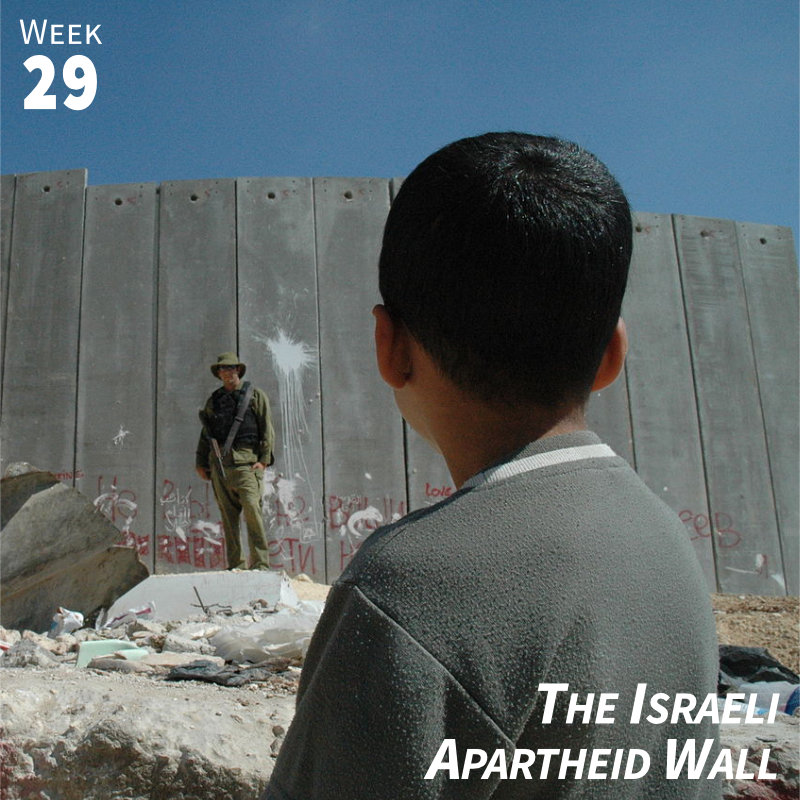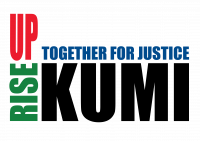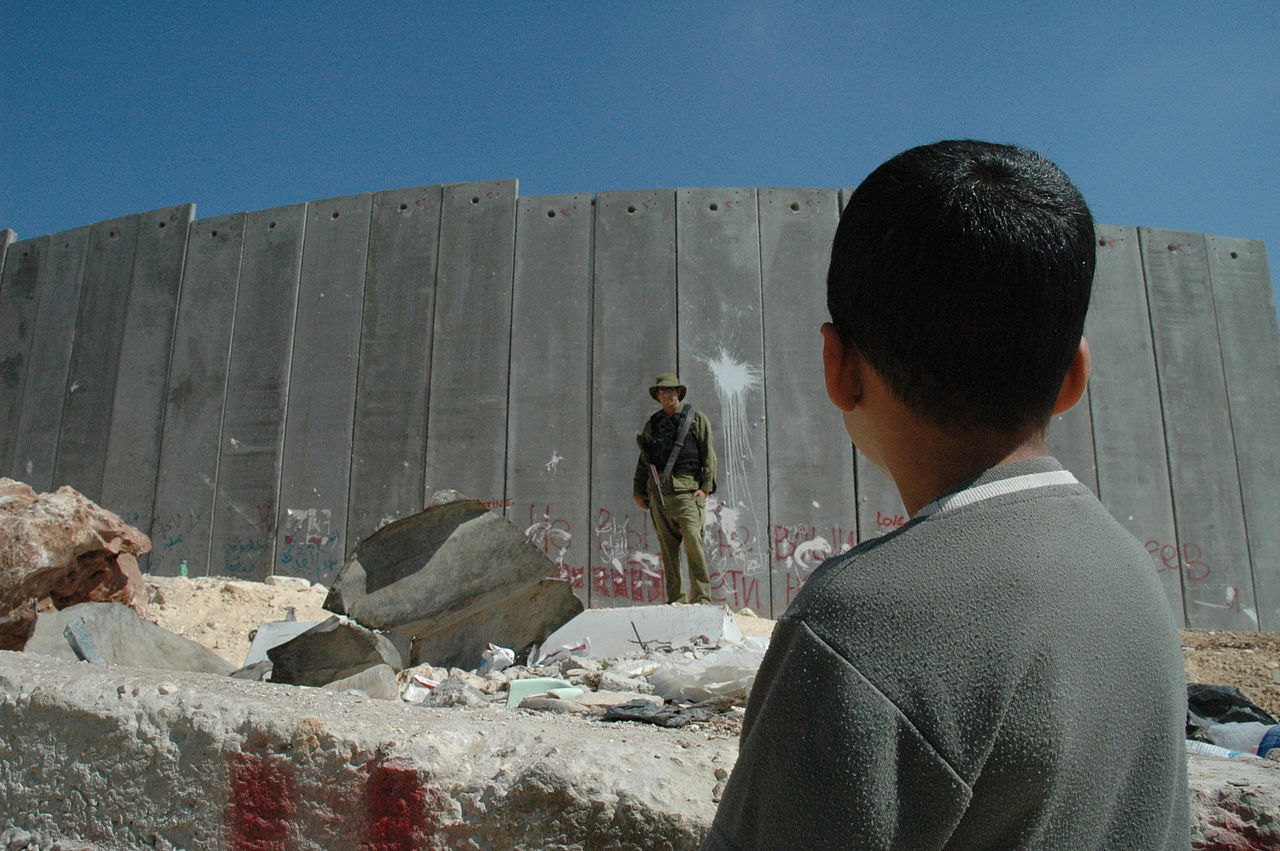Week 29: Israeli Apartheid Wall

Resolution ES-10/15 doesn’t, in name, sound like much. But it was a resolution passed on July 20, 2004 that acknowledged the illegality of Israel’s separation barrier under international law. Years later, Palestinian communities in the occupied territory are still being torn apart due to the construction of the separation barrier, otherwise known as the Apartheid Wall. As the wall gets built, Israel is effectively annexing more and more Palestinian land to itself. Here’s what you need to know about the Israeli Apartheid Wall and what you can do so that together we can rise up.
Topic: Israeli Apartheid Wall
In May 2002, hundreds of Israeli bulldozers entered Palestinian agricultural land and started large scale destruction for what later would turn out to be the start of the construction of Israel’s over-700 kilometers wall. The wall in urban areas is up to eight meters tall, while in rural areas it takes the shape of a maze of fencing, razor wires, patrol roads, watchtowers, and sensors. Together with the military-closed zones and the settlements, Israel uses the wall to prohibit Palestinians access and use of some 60% of West Bank land, including the water sources located there. The wall cuts off villages from each other and bars access to schools, hospitals, and other services for communities that are isolated by the wall and checkpoints.
One of the most common arguments used to justify the wall is that it decreases suicide bombings and is, therefore, essential to Israel’s security. However, Shin Bet, Israel’s security agency, stated that the central reason for the decrease in suicide bombings since 2005 was not the wall but the truce with Hamas. Also, if the wall was primarily built for security then it should run inside Israel’s land or along Israel’s borders. However, 85% of the wall’s path runs inside the West Bank. It is one thing to build a wall on your own land, but quite another to build it on your neighbor’s land. The wall is being used to annex Palestinian land and further solidify Israel’s illegal occupation of the Palestinian territory. It is important to stress that the International Court of Justice declared the construction of the wall illegal in 2004. Often the argument of security is used to both hide and justify the pernicious effects of the wall on the Palestinian community.
Since the signing of the Oslo Agreement in 1993, Israel has systematically worked to ensure Palestinians have been gradually pushed into the 40 percent of what was in the agreements defined as Areas A and B, while colonizing the rest with settlements. The wall in all its shocking cruelty is the culmination of a long-standing Israeli plan.
With the wall over three-quarters finished, Israel is rapidly and relentlessly finalizing the last infrastructural adjustments to close off the areas set aside for Palestinians. For those communities outside these boundaries, Israel continues a plan to expel them from their homes and lands.
If Israel’s plans come to reality, Palestinians will be reduced to living on 13% of their historical homeland. Since the start, Palestinian communities recognized the wall not only as a means to confiscate land and resources but as an expression of Israel’s institutionalized regime of racial discrimination. It re-creates the Bantustans that have been a fundamental element of apartheid in South Africa. They have hence called it the Apartheid Wall.
The wall has profoundly affected farmers, families, access to health care, and other aspects of the lives of Palestinians. Furthermore, it is impossible to contemplate the affects of the Israeli Apartheid Wall without making connections to other barriers around the world, such as the U.S-Mexico border, the barriers around Gaza, and others. Through the week, we will publish and share more stories and essays showing and analyzing these affects and connections, and highlighting the organizations trying to do something about the wall.
Essay contributed by Stop the Wall. Updated for the second edition of Kumi Now.
Story: Khalid Yousef Zeet, George, and the Village of Wad Rahal
Story 1
Already during these early days, Khalid Yousef Zeet, a resident and farmer in Qalqiliya, has lost much of his land. His grandfather lost almost fifty dunums (1 dunum is a quarter of an acre) of land in 1948. Three dunums of cabbage is all Khalid was left with after November 2002 when the Israeli military confiscated his other five dunums of cropland, bountiful with orange, lemon, guava, and olive trees, for the wall.
Khalid continues to work his last three dunums of land despite harassment from Israeli contractors and private security. As most farmers in Qalqiliya, Khalid is repeatedly threatened by the military to stop working even his last remaining land. Recounting the number of instances he was threatened, Khalid laughed, “Over a hundred! But they’ve only shot near me twice to leave.”
The loss of land, which is threatening Khalid’s ability to sustain his family, has brought many of Qalqiliya’s farmers together to support one another in cultivating confiscated lands. Together, farmers risk their safety and lives to harvest what they can in these lands. Khalid’s neighbors share his feelings that the wall is destroying everything—their land, the market, the ability to live, and their freedom.
Story 2
George, from Bethlehem, has to pass checkpoints every day since 2005, either to go to university or to work.
George explains: “The checkpoints are huge obstacles in our lives because they prevent us from moving freely. Checkpoints are the most humiliating experience to human dignity and freedom, when you are exposed to the checking process, even though you are in your own country.
“The presence of the checkpoint affects a person’s entire life. For example, someone who lives in Hebron and wants to visit Tulkarem, will pass at least 5 main checkpoints, and if every checkpoint stops him/her, by the time he/she reaches their destination the day will be over. Also, the checkpoints have instilled fear in people which makes them move or only travel to other cities in a case of emergency. This has a huge negative impact on people and their social life.”
Story 3
Wad Rahal’s residents live in the shadow of Efrat, one of the largest illegal Israeli settlements in the West Bank.
The settlers control Wad Rahal’s water, which flows through a shared water pipe that fills the village’s tanks. During the summer when water is a priceless commodity, villagers say that Efrat cuts their water to one day a week, leaving them to savor the water in their tank for an entire week before refilling it. The main road through Wad Rahal is now blocked. In case of medical emergencies the closest access to medical care is in Bethlehem and people have died on route to the hospital, unable to get medical attention soon enough.
Kumi Action
Send an empty small cardboard box to the Israeli Parliament (Knesset) Foreign Affairs and Defense Committee with a note reading: “Opening checkpoints is as easy as opening this box. Take down the Apartheid Wall!” Send it to the following address:
The Knesset
Attn: Foreign Affairs and Defense Committee
Jerusalem 9195016
Israel
Or send an email that reads “Opening checkpoints is as easy as opening this email. End checkpoints within Palestinian territory and take down the Apartheid Wall!” to the committee’s email address: v_bitachon@knesset.gov.il.
Share a picture of your box and one of the short videos or other items listed under Additional Resources (on the website) on social media. Include a link to this page of the Kumi Now website, a link to the Stop the Wall campaign (https://www.stopthewall.org/call-global-day-interaction-worldwithoutwalls-november-9-2018), and the hashtags #WorldwithoutWalls, #KumiNow, and #Kumi29
Literature: Multiple Quotes
“There is no word for wall in our language. We’ve asked our elders. We have searched. There is no word for wall because there shouldn’t be walls.”
Verlon M. Jose, Tohono O’odham tribal vice-chairperson. The Tohono O’odham people’s land is divided by the U.S./Mexico border.
“Many small people, who in many small places do many small things, can alter the face of the world.”
East Side Gallery, Berlin, 1990
Additional Resources
Videos:
- “Walls of Shame: West Bank Separation Wall” from Al Jazeera English: https://youtu.be/3jcxFxtToF0
- “The Impact of Israel’s Wall” from The Young Turks: https://youtu.be/UZ1lnumIQHY
- “The Illegal Israeli Wall – What You Need to Know in 90 Secods” from Friends of Al-Aqsa: https://youtu.be/UJFKL-wkQQI
- “Book Launch — The Wall and the Gate: Israel, Palestine, and the Legal Battle for Human Rights” from Open Society Foundations: https://youtu.be/clbpyNePW5k
“Factsheet: Companies Building the Apartheid Wall” from Stop the Wall: https://www.stopthewall.org/downloads/pdf/companiesbuildingwall.pdf
“Leaflet: Justice in Palestine – What Can Your Union Do?” from Stop the Wall: https://www.stopthewall.org/leaflet-justice-palestine-what-can-your-union-do
“The Palestinian Periphery: Home Demolitions and Settler Colonialism in the Jordan Valley and South Hebron Hills”, a report from Stop the Wall: https://www.stopthewall.org/new-report-palestinian-periphery-pdf-and-ebook
We have a YouTube playlist with videos about the Israeli Apartheid Wall.
Image Credits
Coming soon

